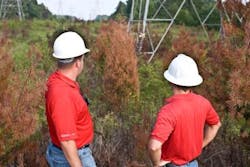When applied as part of an Integrated Vegetation Management program, selective herbicides can complement mowing practices to improve results, reduce long-term maintenance costs and support environmental sustainability throughout utility rights-of-way (ROW). However, if the efficacy of your herbicide treatments ever faulters, it may be time to consider alternative solutions that can optimize control of incompatible vegetation.
Simply applying more herbicide should never be the answer to product performance issues. Instead, follow these three steps to identify program-enhancing chemistries that can restore your ROW to a state that enhances cost efficiency, electrical transmission reliability and the development of biodiverse wildlife habitat:
Step 1: Identify Areas of Improvement
Monitoring the performance of herbicide applications throughout the year is an undeniable responsibility for utility vegetation managers. Taking time at the end of each year to determine what went well and where results can improve is a great place to start when assessing opportunities to strengthen planned treatment cycles for the year to come.
As you assess results in the field, make note of which targeted plants are showing signs of tolerance.
Step 2: Cross-Reference Herbicide-Resistant Plants With Applied Chemistries
After identifying which plant species have grown tolerant to chemistries applied throughout your ROW corridors, check your books to answer the following questions:
1. To which herbicide products have resilient plants grown resistant?
2. Does the equipment and application rate(s) I’ve used align with product label recommendations?
3. When was each herbicide treatment completed?
Having answers to these questions will support the final step of the program evaluation process.
Step 3: Connect With Your Vegetation Management Adviser
Using your responses to the three questions outlined in the previous step, discuss the performance of your herbicide program with a trusted vegetation management adviser. These industry experts can help identify application strategies and/or new modes of action that can improve the control of incompatible vegetation posing a threat to utility infrastructure, your pocketbook and the development of biodiverse wildlife habitat.
In fact, vegetation management specialists with Corteva Agriscience work with utility vegetation managers and their contract partners throughout the year to align on performance-enhancing strategies and industry-leading chemistries that can optimize control of problematic plant species. As trusted industry partners, Corteva vegetation management specialists work to identify and recommend new modes of action that help vegetation managers maintain or improve results from one year to the next.
Blending compatible chemistries is often an effective way to improve broad-spectrum control. That’s why Corteva offers a variety of custom blends through the organization’s Continuum® Prescription Control & Container Management System.
Offered by Corteva to utility vegetation management professionals, the Continuum system is a closed-loop delivery solution that provides straight product or contract mixes to help vegetation managers introduce new modes of action throughout the land they manage. As an added benefit, the Continuum system delivers returnable and refillable containers that require zero mixing, washing or disposal. In addition to improving inventory tracking, the Continuum system enhances cash flow management and minimizes liabilities from theft.
To learn more about the Continuum system and tank-mixed solutions that can enhance control of incompatible plant species that wreak havoc throughout your ROW corridors, contact a vegetation management specialist in your local area.
Why do less with more when you can do more with less? Now’s the time to assess product performance and refine your plans for the 2023 treatment season. For more information on herbicide products, application best practices and success stories from utility customers across the country, visit Utility.VegetationMgmt.com.
™ ® Trademarks of Corteva Agriscience and its affiliated companies. © 2022 Corteva.
Sponsored By:



